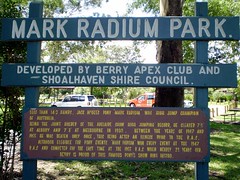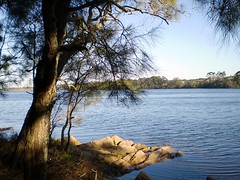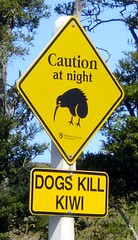Circuit of Australia Day 8: Port Lincoln-Ceduna
- February 18th, 2008
- Posted in Australia
- Tagged map
- No Comments
The Britz office was chaotic. I don’t know if they were short-staffed, or there were more customers than normal, or if they’re just always this shambolic, but they made the whole business of renting out vans seem exceptionally complex. The general approach seemed to be that one member of staff (a different one each time) would suddenly notice me with a start and an “Oh, are you still here?” look, work out what I hadn’t done yet, get me to take the next step, and then tell me to “Now, just wait there for a minute”. They also seemed to pick customers at random: people who came in half an hour after me were on their way well before I was, and one hapless soul who arrived just before me was still wandering around hoping for someone to notice him as I was departing. Even without re-engineering their entire process they could make things ten times better just by telling you at each point what’s going to happen next: “If you wait for a few minutes, Gary will check your driving license and then give you a tour of your vehicle”.
To top it off, the directions they gave me for how to get out onto the highway were rather useless. They presumably give these same directions hundreds of times a week, so by now you’d think that they would be able to warn people that the road is not actually straight, but bends to the right, and if you make the mistake of going straight ahead at that point, you’ll end up driving into a series of dead-ends around the Qantas base. I expect this is just a classic case of assumed knowledge. There are signposts at the junction so it’s obvious which way you should go. Of course, I suspect I’m not unusual in not knowing what any of the districts of Sydney are called or which signs I should follow to get me out towards Highway 1.
Eventually I manage to make sense of my various maps and find my way out onto the Princes Highway and follow the signs south towards Woolongong. Very quickly I am warned about the dangers of Equine Flu and how, should I be transporting horses, I absolutely must not leave the purple zone (whatever that may be).
Even though I’m starting from the south of the city, Sydney sprawls out for much further than expected. The first 20km or so are all quite run-down semi-industrial outskirts, eventually turning into quite pleasant suburban areas with treelined avenues. It’s about 35km out before the city really fizzles out into open fields of trees, pylons, and telegraph poles. Shortly thereafter I’m a little confused by a sign that informs me I’ve reached the end of the 1 and am now joining the 1. With some reflection I realise that this is something like the journey from Belfast to Dublin that used to involve an A1 / M1 (northern) / N1 / M1 (southern) combination, although here the 1s are differentiated merely by differently shaped shields around them, rather than helpful prefixes. The new stretch doesn’t seem to quite be ‘motorway’ equivalent, as cyclists are still allowed, but the speed limit has risen 100km/h to 110km/h, which is quite a pleasant surprise after New Zealand where I don’t think any roads ever go above 100.
After a brief stop for lunch in Woolongong, I’m back on the road, marvelling at how many quite abstract road warning signs there are: i.e. signs that aren’t warning about anything imminent, but just warning me to take a break every two hours (“Stop – Revive – Survive”), or telling me, should I be a motorcyclist, how to handle bends in the road (“Plan your corners! Start wide – finish tight”) – with helpful diagrams, of course. Maybe I’ve just blotted them out, or familiarity dulled me to their presence, but I don’t remember the UK, the world leader in warning signage, having anywhere near as many signs as this. No doubt they will soon…
 An hour later, but a hundred years earlier, comes Berry: “Where it all begins”. I was expecting it be a couple more days before I stumbled across a small town quite like this. I stop off in a small park, named after the pony that was high-jump champion of Australia between 1938 and 1955! Were I making my way much slower, then this would be a great place to stay the night. There’s plenty of shade, well kept toilets, and clean gas-powered barbecues. And indeed, even by early afternoon it looks like there’s quite a few vans already parked up for the night. But I want to be doing at least 2-3 times this distance each day, so after a quick visit back into the town for some supplies, I head off again, hoping that I’ll find somewhere else so pleasant further down the road.
An hour later, but a hundred years earlier, comes Berry: “Where it all begins”. I was expecting it be a couple more days before I stumbled across a small town quite like this. I stop off in a small park, named after the pony that was high-jump champion of Australia between 1938 and 1955! Were I making my way much slower, then this would be a great place to stay the night. There’s plenty of shade, well kept toilets, and clean gas-powered barbecues. And indeed, even by early afternoon it looks like there’s quite a few vans already parked up for the night. But I want to be doing at least 2-3 times this distance each day, so after a quick visit back into the town for some supplies, I head off again, hoping that I’ll find somewhere else so pleasant further down the road.
Although my van is equipped with a CD player, I didn’t actually bring any CDs with me, so I’m hoping to get good radio signals for most of this part of the trip at least. The most consistent signal seems to be ABC News, so I spend much of the afternoon listening to the political wranglings over the upcoming apology to the Stolen Generations, and the new rules for junior football (of the soccer variety), where to make the game fairer to all players goalkeepers have been scrapped, and no-one is now allowed to score more than three goals per game!
Part of my plan is also to navigate my way by tourist maps. I have one full country map that shows major roads, but beyond that I’m reliant on local area guides that I hope to be able to pick up in tourist information centres. These tend to be better than the maps you’ll get in all but the most detailed atlases, so I’m stopping at pretty much every info centre I see, and picking up armfuls of guides. I’m also hoping to camp most nights in National Parks, so I’m hoping to find good guides to this too, as well as info on interesting things to see and do on the way. I have one slim all-country guidebook, but for a country so huge it can only list the major attractions, and I’m hoping to see more of the quirky off-beat things that probably won’t even make it into most of the single state guidebooks. As such, I’m extremely tempted by Mogo Zoo, purely as it seems so out of place. Mogo itself is just a tiny village (pop: 257!) and really has no business having a zoo. This would be like driving up the Antrim Coast and seeing a sign to Cushendun Zoo. But I still need to buy a pillow somewhere, and nowhere in Mogo looks plausible for that, so instead I press on and explore Moruya instead: another strange little town with lots of carved wooden statues, and, more usefully, a general store that amazingly enough has a sale on on pillows!
 And then, another 15 minutes down the road, I pass through Bodalla, the self-proclaimed “Killarney of the South”, and discover a nice little forest park that is set up for overnight stays. It’s not quite as nice as the park in Berry, but it’s significantly bigger and there are quite a lot of vans parked up and people making their dinner. I pick a spot, work out how to set up my sleeping quarters, and then head off to explore the forest walk that’s signposted. It seems like it would be rather easy to drift off-track at any number of points, mainly because there isn’t really a track per se for most of the way, with the path seemingly having merely evolved over time through repeated walking. However, at several points along the way someone has crafted wooden steps at particularly steep parts, so there must be some level of official status to it all. Eventually I arrive at what seems to be a rather muddy and not very appealing lake, but a few hundred metres further through the trees it opens up properly into something much more pleasant indeed, with a little bench thoughtfully provided to sit and soak in the view.
And then, another 15 minutes down the road, I pass through Bodalla, the self-proclaimed “Killarney of the South”, and discover a nice little forest park that is set up for overnight stays. It’s not quite as nice as the park in Berry, but it’s significantly bigger and there are quite a lot of vans parked up and people making their dinner. I pick a spot, work out how to set up my sleeping quarters, and then head off to explore the forest walk that’s signposted. It seems like it would be rather easy to drift off-track at any number of points, mainly because there isn’t really a track per se for most of the way, with the path seemingly having merely evolved over time through repeated walking. However, at several points along the way someone has crafted wooden steps at particularly steep parts, so there must be some level of official status to it all. Eventually I arrive at what seems to be a rather muddy and not very appealing lake, but a few hundred metres further through the trees it opens up properly into something much more pleasant indeed, with a little bench thoughtfully provided to sit and soak in the view.
I keep an eye out whilst trekking around for snakes, spiders, and other miscreants. My knowledge of Australian wildlife isn’t well enough developed to know what to expect where, but I’m happy enough for now to stick with a blunt “avoid anything that moves”. All I see on this walk, however, is an impressively large insect that keeps scuttling along the ground about 5 metres in front of me and hops out of range each time I try to take its photograph. Later, when sitting at a picnic table, reading a book, I feel a tickle on my left arm, and discover a red ant racing up towards my elbow, but as for anything bigger than an insect, despite seeing several kangaroo warning signs, today I’ve seen nothing but a solitary grazing goat.
 Sometimes a sign is just so fantastic that, despite my inability to take photos whilst driving, I just have to stop and reverse or drive around the block again, or whatever, just to get a shot.
Sometimes a sign is just so fantastic that, despite my inability to take photos whilst driving, I just have to stop and reverse or drive around the block again, or whatever, just to get a shot.
This one just confused me on so many levels I couldn’t ignore it. At a purely grammatical level I was surprised that dogs kill “kiwi” and not “kiwis”. This called for some further research, whereupon I discovered that although Wiktionary only gives the “kiwis” form, the Wikipedia page on English plural has an interesting discursion on how words of Maori origin can be pluralised with or without an -s.
At a purely practical level, however, I’m completely confused as to what I, as a driver, am meant to do upon encountering this sign. It’s not like I’m travelling with a pack of dogs in the back of my car that I would otherwise have let loose at the first sign of a kiwi. And it can’t just be a simple warning that there may be dead kiwi(s) littering the highway, as it explicitly warns me to be cautious at night. Although the kiwi is generally a nocturnal creature, one would presume that a dead kiwi doesn’t burst into flames or disintegrate into a pile of dust once hit by direct sunlight, and thus a “be careful you don’t run over any dead kiwi” warning should apply at all hours.
So I’m left with the rather unsettling conclusion that I’m meant to be careful I don’t drive into the midst of a frenzied midnight kiwi killing spree, lest the bloodthirsty dogs, freshly exhilarated from the kill, turn on me next.